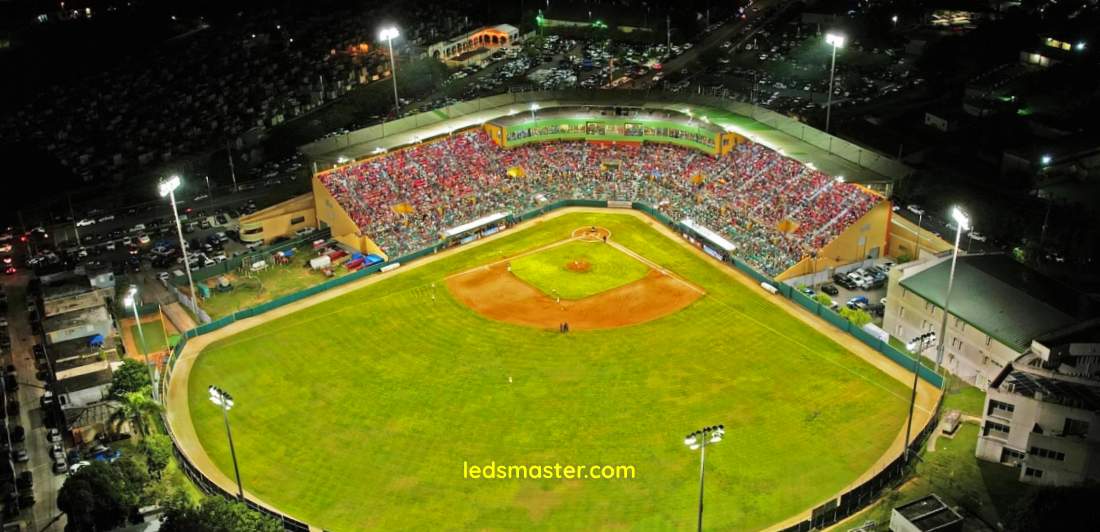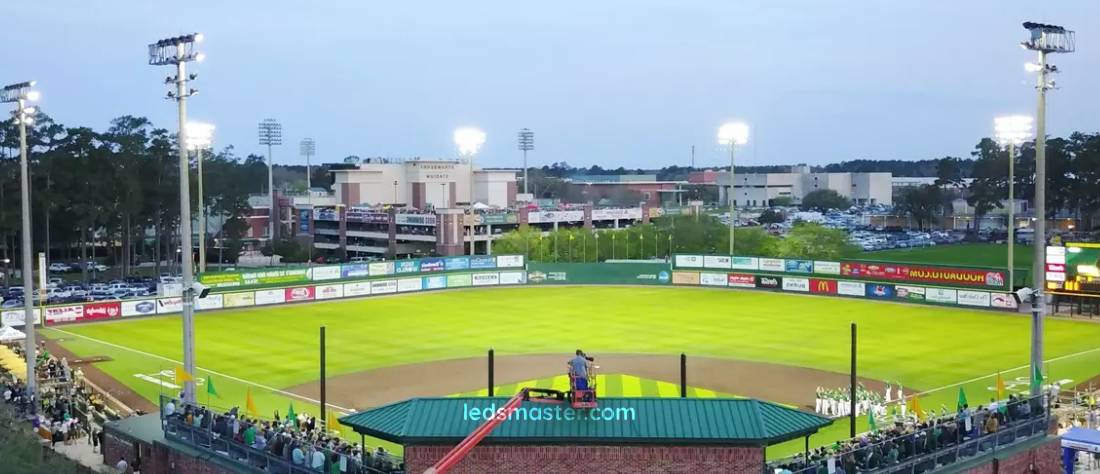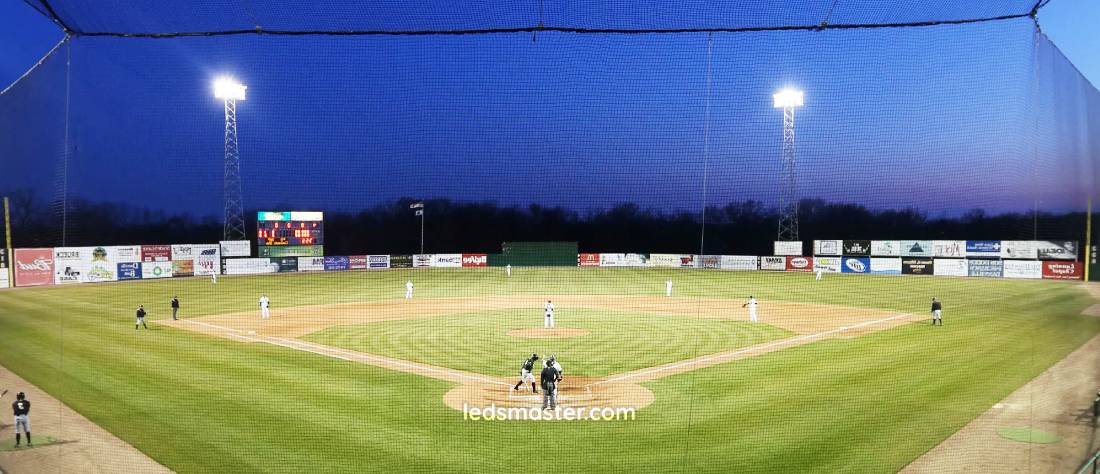A carefully designed lighting system enhances visibility, promotes safety, and provides an enjoyable experience for both athletes and spectators. In this article, we will explore key aspects of softball field lighting design, including the optimal number of lights, ideal color temperature, appropriate pole height, and ways to ensure uniform illumination across the field.
Get your complimentary lighting design today
Designing lighting for a softball field requires careful planning to ensure visibility, safety, and an optimal playing experience for both players and spectators. The lighting design must take into account factors such as the number of lights needed, the ideal color temperature, and the proper height of the light poles. In this guide, we will explore these critical aspects to help you achieve a well-lit softball field that enhances performance and minimizes visual discomfort.
Table of Contents
ToggleThe number of lighting fixtures required for a softball field depends on the size of the field, the level of play, and the desired lighting uniformity. The primary goal is to achieve even lighting across the entire field, eliminating dark spots and ensuring that players can see clearly in all areas.
For recreational or community-level fields, a typical setup may require four to six light poles, strategically placed around the field. However, for professional or tournament-level fields, the number of lights may increase to ensure more precise illumination and meet the higher standards required for competitive play.
The placement of the lights should be carefully planned to cover key areas, such as the infield, outfield, and foul lines. Lighting should be uniform across these zones to avoid any advantages or disadvantages to players based on their position on the field.
Several factors can influence the number of lights required, including the size of the field, the lighting intensity needed (measured in lux), and the type of light fixtures used. LED lighting, for example, is highly efficient and can provide brighter, more focused illumination, potentially reducing the number of fixtures needed compared to traditional lighting technologies.

The color temperature of lighting is a critical factor in designing a softball field’s illumination system. Color temperature is measured in Kelvin (K), and it determines the “warmth” or “coolness” of the light emitted. For outdoor sports like softball, a cooler color temperature, typically between 5000K and 6000K, is ideal.
This range of color temperature mimics natural daylight, providing players and spectators with a clear, crisp view of the field. The cooler tones of light enhance contrast, making it easier to track the ball and react to plays. Additionally, these cooler temperatures reduce glare, which can be distracting and impair performance.
Consistency in color temperature across all lighting fixtures is essential for uniform visibility. Mixing different color temperatures can lead to uneven lighting and cause distractions for both players and spectators. By maintaining a consistent color temperature, you ensure that the field is evenly illuminated and visually comfortable for everyone involved.
Choosing LED lights, which are available in a wide range of color temperatures, provides more control over the lighting environment. LED fixtures allow for precise adjustments to color temperature, ensuring that the lighting design meets the specific needs of the field.

The height of the light poles is another crucial consideration in softball field lighting design. Light poles that are too short may not provide adequate coverage, while poles that are too tall can lead to excessive light spill or glare. The optimal height for light poles on a softball field typically ranges from 40 to 60 feet, depending on the size of the field and the number of lights used.
For smaller fields, light poles around 40 to 50 feet tall are generally sufficient to ensure even illumination. For larger fields or professional-level installations, poles closer to 60 feet may be required to cover a broader area and provide higher-quality lighting.
Several factors can influence the height of the light poles, including the layout of the field, the positioning of the fixtures, and the intensity of the lighting required. Taller poles allow for a wider distribution of light, reducing the need for additional fixtures. However, they must be positioned carefully to avoid creating excessive shadows or glare.
The placement of the poles should also take into account the needs of the spectators, ensuring that the lighting provides clear visibility from the stands without causing discomfort. Properly angled fixtures can help direct the light onto the field while minimizing light pollution or spillover into neighboring areas.
Lighting intensity is measured in lux, which refers to the amount of light per square meter. The recommended lux levels for a softball field vary depending on the level of play. For recreational and community-level fields, a lux level of around 300 lux is typically sufficient for nighttime games. However, for competitive or professional-level fields, the recommended lux level can range from 500 to 1000 lux, depending on the specific requirements of the league or governing body.
Higher lux levels provide clearer visibility, which is essential for fast-paced sports like softball, where players need to react quickly to balls traveling at high speeds. Achieving the right lux level ensures that the entire field is well-lit and safe for play.

Uniformity in lux levels across the field is essential to avoid creating bright spots or shadows. This can be achieved through careful placement of light fixtures and the use of LED lights, which offer precise control over light distribution. Proper aiming and focusing of the lights ensure that the infield and outfield receive consistent illumination, enhancing both gameplay and safety.
While providing adequate lighting for the field is important, it is equally critical to minimize light pollution, especially if the field is located near residential areas. Light pollution can cause discomfort for neighbors and contribute to environmental issues.
To address this, lighting fixtures should be designed with shields or hoods that direct the light onto the field, preventing unnecessary spillover. LED lighting is particularly effective in minimizing light pollution due to its focused beam control and energy efficiency. Proper aiming and positioning of the fixtures also play a key role in reducing light spill.
Energy efficiency is another important consideration in softball field lighting design. LED lights are the preferred choice due to their low energy consumption, long lifespan, and reduced maintenance costs. Compared to traditional lighting systems, LED lights can significantly reduce energy usage while providing brighter and more focused illumination.
Sustainable lighting practices, such as using energy-efficient fixtures and minimizing light pollution, contribute to the overall environmental impact of the field. By choosing the right lighting system, you can reduce energy consumption and ensure that the field operates efficiently over time.
Designing a lighting system for a softball field requires careful consideration of several key factors, including the number of lights, color temperature, pole height, and lux levels. Achieving the right balance between these elements ensures that the field is well-lit, safe, and enjoyable for both players and spectators. With the use of modern LED lighting technology, you can create a highly efficient, sustainable, and visually comfortable lighting environment that enhances the overall game experience.